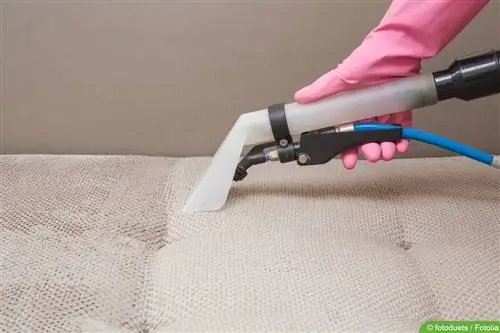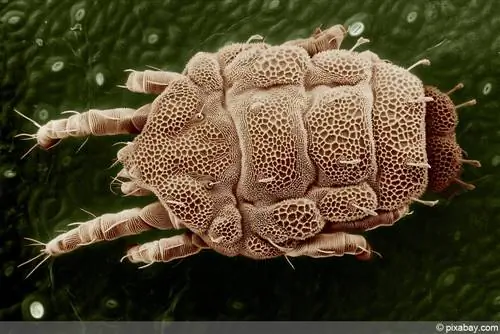- Author admin [email protected].
- Public 2023-12-17 03:39.
- Last modified 2025-01-24 12:45.
It is not possible to see mites in bed with the naked eye because the arachnids are only 0.1 to 0.5 millimeters in size. However, the signs of bed mites are clear and relatively easy to detect.
Nutrition and habitat
Bed mites feed on skin flakes, hair and other dead cells that contain keratin. Therefore they are mainly found in:
- Bed linen
- pillow
- Mattresses
- Upholstered furniture
- Carpets
- Pet beds
Textiles are fundamentally affected. This can also include towels and clothing. They also prefer moist, warm areas. This makes the bedroom and the bed particularly attractive. Encasing mattresses, bed linen, etc. can reduce contact with mites.
Detecting bed mite infestation
Identifying bed mites and being able to classify the symptoms is not easy. Because the symptoms are very similar to a cold, especially at the beginning. However, there are some signs that clearly point to arachnids and the problems they cause. This includes the duration and time of occurrence. Typical are:
- persistent complaints for more than two weeks
- Discomfort when waking up
- Relief through ventilation
- Improvement throughout the day
Note:
If even an air purifier with a HEPA filter and a complete change of bed linen and mattress do not bring any improvement, you should urgently consult a doctor. Because then the problem is most likely not caused by the arachnids.
Symptoms
There are various physical symptoms and signs of a bed mite infestation.

Difficulty breathing
Swelling of the respiratory tract can lead to problems with air supply. In these cases you should urgently consult a doctor. Initially, a “dense” nose is characteristic immediately after waking up. In some cases, this problem can even wake you up.
Eyes
One of the first signs of an excessive number of mites in the bed is eye irritation. Typical symptoms are:
- increased tear flow
- Itching
- Redness
- Pain
- Swelling
Rash
When mites bite people or animals, they leave traces. Typical consequences of this are:
- Itching
- Points
- Redness
- Swelling
Inflammation can also occur. These are particularly likely and pose a risk if you scratch the bites and thereby create a secondary infection. Bacteria, viruses or fungal spores can be carried into the wounds via the fingernails.
cough
The allergens in the mite droppings cause the mucous membranes to swell and produce more secretions. The bronchi try to get rid of the mucus and trigger a cough. This is often accompanied by sputum.

Headache
Just like a cold, tension headaches can occur. The head presses and hurts, appears heavy and can throb. What is often noticeable is that the pain gets worse with exertion and occurs immediately after waking up or disrupts sleep.
Sneezing and runny nose
The mite droppings irritate the mucous membranes of the respiratory tract and can cause sneezing and cold-like symptoms. The mucous membranes produce more secretion and swell. In addition, messenger substances are produced that trigger inflammatory reactions.
This leads to the following symptoms:
- difficult breathing
- Sinus pressure
- runny and stuffy nose
More signs
If the dog and cat also sleep on the couch or in bed or if the partner and children suffer from similar symptoms, it must be assumed that there is a case of mites. Constant scratching, loss of fur and sore spots are particularly noticeable in pets.
Allergy
If a large number of mites are found in the mattress, this can cause long-term allergies. This is not directly due to the animals themselves. However, their feces contain allergens. These can cause various symptoms and irritations. These get worse when dust is stirred up. This can be the case, for example, if you use air conditioning or set up a fan. The first signs of this can resemble a cold.

Prevention
Since the mites prefer warm, humid areas and can multiply and spread very quickly, especially in summer, you should take appropriate measures. This includes, among other things:
- shower in the evening
- Air the bed, blanket and pillow and let it dry during the day
- Change mattress every seven years at the latest
- regular washing at high temperatures of at least 60 degrees Celsius
- correct and frequent ventilation
- Temperature in the bedroom should preferably not exceed 18 degrees Celsius
This does not make it possible to remove all mites or keep them away safely. However, the number is noticeably reduced.






